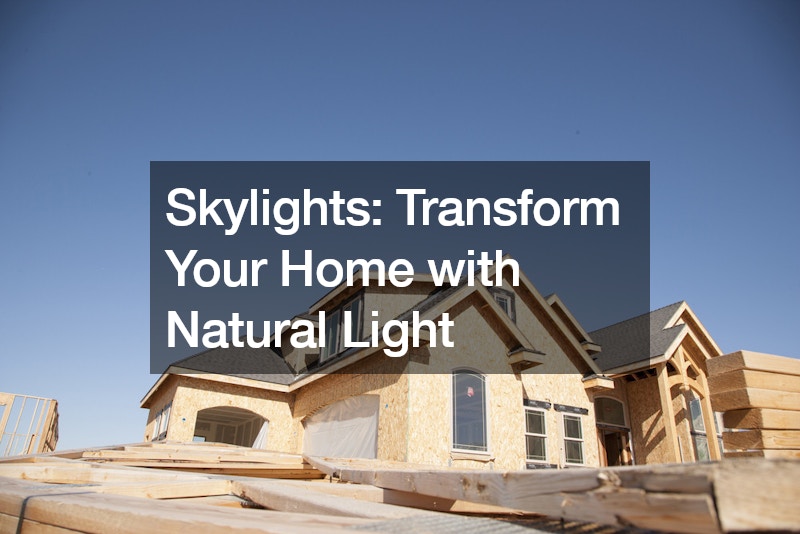For many homeowners, the quest for a brighter, more inviting home can feel like an elusive dream. We spend countless hours debating paint colors, agonizing over finishes, and rearranging furniture, all in pursuit of creating a warm and uplifting space. But what if the key to achieving this dream lies not within the walls of your home, but above them?
Skylights offer a powerful solution for transforming your living space by bathing it in natural light. They are not merely a fad, but a timeless design element with the potential to revolutionize the way you experience your home.
Benefits of Natural Light
Natural light goes beyond simply illuminating a room. It has a profound impact on our well-being, mood, and even productivity. Studies have shown that exposure to natural light can:
- Boost mood and energy levels: Natural light helps regulate our circadian rhythm, the internal clock that controls sleep and wakefulness. Increased natural light exposure can lead to feelings of alertness and improved mood.
- Enhance productivity: Studies have shown that workers in naturally lit environments experience increased productivity and focus. Natural light can also reduce eye strain, a common complaint in spaces reliant on artificial light.
- Create a healthier environment: Natural light can help kill bacteria and reduce mold growth, contributing to a healthier indoor environment.
- Reduce energy consumption: By relying less on artificial lighting during the day, skylights can help you save on your energy bills.
Choosing the Right Skylight
With the decision to incorporate skylights into your home comes a range of choices. Here are some key factors to consider:
- Shape and Material: Skylights come in two primary shapes: flat and domed. Flat skylights, typically made of glass, offer a clear view of the sky and are ideal for stargazing. Domed skylights, often constructed from plastic or acrylic, are more affordable and allow for better water runoff. However, they may discolor over time.
- Energy Efficiency: For optimal energy efficiency, consider tinted or low-emissivity (low-e) glass. This will help regulate the temperature in your home, preventing the creation of an unwanted “thermal chimney” effect, especially in warmer climates.
- Fixed or Vented: Skylights can be either fixed or vented. Fixed skylights provide a beautiful source of natural light but lack ventilation. Vented skylights, on the other hand, allow for hot air to escape, promoting better air circulation. While vented skylights are generally more expensive, they can ultimately contribute to energy savings.
Positioning for Optimal Light
The placement of your skylights plays a crucial role in the type of light you receive. Here’s a breakdown of how skylight location affects light distribution:
- North Facing: Skylights positioned on the north side of your roof offer the most consistent natural light throughout the day. This is a great choice for living areas, kitchens, or home offices.
- East or West Facing: These locations provide softer, warmer light in the morning or afternoon, respectively. This is ideal for bedrooms or bathrooms, where a more subdued light can create a relaxing atmosphere.
- South Facing: While seemingly counterintuitive, south-facing skylights strategically placed on a sloping roof can be surprisingly effective. They create a more even light distribution, perfect for illuminating creative spaces like studios or dark interior rooms.
Additional Considerations
Beyond the basic choices, there are a few additional factors to keep in mind:
- Local Regulations: Building codes in your area may have specific regulations regarding skylight installation. It’s important to consult with a professional to ensure your chosen skylights comply with local requirements.
- Professional Installation: Skylight installation can be complex and requires proper waterproofing to prevent leaks. Hiring a qualified professional for installation will ensure the job is done correctly and your skylights function optimally for years to come.
- Maintenance: Regularly cleaning your skylights will maintain their clarity and maximize natural light intake. Additionally, for vented skylights, ensure the venting mechanism is functioning properly to maintain good air circulation.
Creative Applications of Skylights
Skylights are not limited to traditional applications. Here are some innovative ways to incorporate skylights into your home design:
- Stairwells: Natural light streaming down a stairwell can brighten up a typically dark space and enhance its visual appeal.
- Bathrooms: Bathrooms often lack natural light, making them feel cramped and uninviting. Strategically placed skylights can transform a bathroom into a spa-like retreat bathed in soft, natural light.
- Walk-in Closets: Skylights can eliminate the need for constantly turning on lights in walk-in closets, making it easier to see your clothes and accessories.
- Interior Courtyards: Homes with interior courtyards can use skylights to flood the space with natural light, creating a beautiful and inviting outdoor oasis.
Final Considerations
Skylights are a powerful design element with the potential to transform your home. However, it’s important to weigh the benefits against potential drawbacks. For example, skylights can add heat gain during the summer months, so proper insulation and ventilation strategies are crucial. Additionally, skylights require maintenance to ensure their optimal performance.
By carefully considering your needs, preferences, and climate, skylights can become a valuable addition to your home, offering a wealth of benefits that extend far beyond simply increasing brightness. They can create a healthier, more inviting, and visually stunning living space, all while fostering a stronger connection to the natural world outside.
.












